Submitted:
17 September 2023
Posted:
18 September 2023
You are already at the latest version
Abstract
Keywords:
1. Introduction
2. Tests design
2.1. Project overview
2.2. Model overview and design of similar material
2.3. Arrangement of acceleration sensors
2.4. Optical displacement measurement system
2.5. Seismic waves and loading conditions
3. The PGD distribution of the slope surface and dynamic damage development of the slope
4. Analysis of acceleration response
4.1. Acceleration of the slope
4.2. The PGA amplification factor of the slope
5. Numerical simulation of the dynamic response of the front slope of loess tunnel
5.1. Models and parameters
5.2. Dynamic response of slope displacement and peak acceleration
5.3. PGD and PGA of the tunnel variation with distance from tunnel portal
6. Discussions
7. Conclusion
- (1)
- The main deformation style of the slope was horizontal movement and settlement when the seismic wave input was in the X and X-Z directions, respectively. On average, the PGDX was approximately 4.97 – 5.5 times and 4.91 – 5.22 times as large as the PGDZ when the input WT wave and El wave was in the X direction, respectively. Whereas, the average PGDX was approximately 4.42 – 5.78 times and 4.83 – 5.12 times as large as the average PGDZ when the input WT wave and El wave was in the X-Z direction, respectively. Therefore, the horizontal deformation was the primary deformation, and the X direction seismic wave had a greater impact on the deformation of the slope. The tunnel entrance slope was destroyed under the action of a large horizontal seismic acceleration. Slope failure ahead of a tunnel can be divided into four stages, i.e. elastic deformation stage, plastic deformation accumulation stage, local failure stage, and block failure stage. Under loading condition of SN9, PGDX mutation of the slope surface indicated the slope failure, and critical horizontal displacement was 48 mm.
- (2)
- From the PGA distribution of slope with tunnel, it could be seen that under the action of different seismic waves, and the obvious amplification effect appeared at the top of the slope and near the empty surface. The existence of the tunnel had a great influence on the PGA and the PGAAF of the ground surrounding it. Especially, the inhibition effect on the soil mass below the tunnel was the most obvious. However, this inhibition effect gradually weakened with the increasing of seismic wave peak acceleration. Additionally, the deformation of the slope with tunnel during the earthquake could be identified according to either the PGD, PGAAF or PGA. Particularly, it could be obviously explained by using the PGD when the large deformation of the slope first occurred.
- (3)
- The existence of the tunnel had a great influence on the PGA of the soil mass surrounding it. This was because the seismic waves encounter a tunnel surface with clear differences in the physical properties of the medium during their propagation in the slope body, thereby forming a strong reflection and refraction effect, and the amplitude changes significantly. The seismic waves were scattered and refracted near the tunnel, resulting in a complex superposition of waves and decreased amplitude.
- (4)
- The results from the numerical simulations were basically consistent with the experimental results, it showed that when the earthquake was strong, the tunnel portal section was firstly damaged under horizontal shear actions.
Author Contributions
Funding
Data Availability Statement
Conflicts of Interest
References
- Liu, D.S. Loess and the environment. Beijing: China Ocean Press 1985.
- Deng, J.; Wang, L.M.; Zhang, Z.Z.; Bing, H. Microstructure characteristics and forming environment of late Quaternary Period loess in the Loess Plateau of China. Environ. Earth Sci. 2010, 59, 1807–1817. [Google Scholar] [CrossRef]
- Chang, W.B.; Wang, P.; Wang, H.J.; Chai, S.F.; Yu, Y.F.; Xu, S.Y. Simulation of the Q2 loess slope with seepage fissure failure and seismic response via discrete element method. B. Eng. Geol. Environ. 2021, 80, 3495–3511. [Google Scholar] [CrossRef]
- Xu, Y.R.; Allen, M.B.; Zhang, W.H.; He, H.L. Landslide characteristics in the Loess Plateau, northern China. Geomorphology 2020, 359, 107150. [Google Scholar] [CrossRef]
- Tao, H.; Zhang, M.M.; Gong, L.; Shi, X.; Wang, Y.J.; Yang, G.Q.; Lei, S.W. The mechanism of slope instability due to rainfall-induced structural decay of earthquake-damaged loess. Earthquake Research Advances 2022, 2, 49–57. [Google Scholar] [CrossRef]
- Wang, J.D.; Li, P.; Gu, Q.; Xu, Y.J.; Gu, T.F. Changes in tensile strength and microstructure of loess due to vibration. J. Asian Earth Sci. 2018, 169, 298–307. [Google Scholar] [CrossRef]
- Wang, L.M.; Pu, X.W.; Wu, Z.J.; Xu, S.H.; Liu, K. Shaking table tests on dynamic response of loess slopes under coupling effects of earthquakes and rainfalls. Chinese Journal of Geotechnical Engineering 2018, 40, 1287–1293. [Google Scholar]
- Xie, D.Y.; Feng, Z.Y. Consideration of some fundamental viewpoints in studying effective stress of unsaturated soils. Chinese Journal of Geotechnical Engineering 2006, 28, 170–173. [Google Scholar]
- Tang, H.M.; Jia, H.B.; Hu, X.L.; Li, D.W.; Xiong, C.R. Characteristics of landslides induced by the great Wenchuan earthquake. J. Earth Sci-China. 2010, 21, 104–113. [Google Scholar] [CrossRef]
- Wang, L.M.; Wu, Z.J.; Xia, K.; Liu, K.; Wang, P.; Pu, X.W.; Li, L. Amplification of thickness and topography of loess deposit on seismic ground motion and its seismic design methods. Soil Dyn. Earthq. Eng. 2018, 126, 1–12. [Google Scholar] [CrossRef]
- Wu, Z.J.; Zhang, D.; Wang, S.N.; Liang, C.; Zhao, D.Y. Dynamic response characteristics and deformation evolution of loess slopes under seismic loads. Eng. Geol. 2020, 267, 105507. [Google Scholar] [CrossRef]
- Wu, Z.J.; Zhao, D.Y.; Che, A.L.; Chen, D.W.; Liang, C. Dynamic response characteristics and failure mode of slopes on the loess tableland using a shaking-table model test. Landslides 2020, 17, 1–5. [Google Scholar] [CrossRef]
- Pu, X.W.; Wang, L.M.; Wang, P. Initiation mechanism of mudflow-like loess landslide induced by the combined effect of earthquakes and rainfall. Nat. Hazards 2021, 105, 3079–3097. [Google Scholar] [CrossRef]
- Cheng, X.S.; Zhou, X.H.; Liu, H.B.; Zhou, Y.C.; Shi, W. Numerical Analysis and Shaking Table Test of Seismic Response of Tunnel in a Loess Soil Considering Rainfall and Traffic Load. Rock Mech. Rock Eng. 2021, 54, 1005–1025. [Google Scholar] [CrossRef]
- Sun, W.Y.; Yan, S.H.; Ma, Q.G.; Liang, Q.G.; Ou, E.F.; Cao, X.P.; Wang, J.H.; Luo, X.X. Dynamic response characteristics and failure mode of a bias loess tunnel using a shaking table model test. Transp. Geotech. 2021, 31, 100659. [Google Scholar] [CrossRef]
- Liang, Q.G.; Bian, L.; Zhang, Q.P.; Huang, J.; Wang, M. Study on seismic dynamic characteristics of large section loess tunnel portal. Journal of Highway and Transportation Research and Development 2018, 35, 65–76. [Google Scholar]
- Zhang, J.D.; Liang, Q.G.; Pu, J.J.; Wang, L.L.; Chai, S.F. Experimental study on shaking table model of portal section of loess tunnel with different tunneling elevations. Journal of Highway and Transportation Research and Development 2018, 35, 77–85. [Google Scholar]
- Bian, L.; Liang, Q.G.; Zhang, Q.P. Experimental study on seismic responses of slope and portal of loess tunnel. Railway Standard Design 2018, 62, 79–84. [Google Scholar]
- Fang, J.; Liang, Q.G.; Zhang, Q.P.; He, P. , Wang L.L. Numerical simulation of dynamic responses of loess tunnel portal section with the consideration of tunneling elevation on the slope. Earthquake Engineering and Engineering Dynamics 2018, 38, 152–161. [Google Scholar]
- Wang, M.; Liang, Q.G.; Wang, L.L. Large-scale shaking table model study on dynamic response of loess tunnel side slope. Earthquake Engineering and Engineering Dynamics 2019, 39, 141–150. [Google Scholar]
- Hashash, Y.M.A.; Hook, J.J.; Schmidt, B.; Yao, J. I-C. Seismic design and analysis of underground structures. Tunn. Undergr. Sp. Tech. 2001, 16, 247–293. [Google Scholar] [CrossRef]
- Wang WL, Wang TT, Su JJ, Lin CH, Seng CR, Huang TH. Assessment of damage in mountain tunnels due to the Taiwan Chi-Chi Earthquake. Tunn. Undergr. Sp. Tech. 2001, 16, 133–150. [Google Scholar] [CrossRef]
- Wang, S.S.; Gao, B.; Sui, C.Y.; Wen, Y.M. Shaking table test for seismic behavior of upward slope at tunnel entrance in different geological conditions. Rock and Soil Mech. 2014, 35, 278–284. [Google Scholar]
- Gao, B.; Wang, S.S.; Wang, Y.X.; Shen, Y.S. Aseismic Study on Mountain Tunnels in High-Intensity Seismic Area. Proceedings of the 2nd Czech-China Scientific Conference. [CrossRef]
- Kazmi, Z.A. ; Extraction of Lagrangian Ground Displacements and Subsurface Seismic Stress Changes for Rational Earthquake Disaster Mitigation. Tokyo: University of Tokyo, 2013. [CrossRef]
- Yu, H.T.; Chen, J.T.; Yuan, Y.; Zhao, X. Seismic damage of mountain tunnels during the 5.12 Wenchuan earthquake. J. Mt. Sci-Engl. 2016, 13, 1958–1972. [Google Scholar] [CrossRef]
- Cui, G.Y.; Wang, M.N.; Lin, G.J.; Wang, W.J.; Zhang, D. Statistical analysis of earthquake damage types of typical highway tunnel lining structure in Wenchuan seismic disastrous area. Chinese Journal of Geological Hazard and Control 2011, 22, 122–127. [Google Scholar]
- Wang, Z.Z.; Gao, B.; Jiang, Y.J.; Yuan, S. Investigation and assessment on mountain tunnels and geotechnical damage after the Wenchuan earthquake. Science in China (Series E: Technological Sciences) 2009, 52, 546–558. [Google Scholar] [CrossRef]
- Asakura, T.; Shiba, Y.; Matsuoka, S.; Oya, T.; Yashiro, K. Damage to Mountain Tunnels by Earthquake and Its Mechanism. Doboku Gakkai Ronbunshu 2000, 659, 27–38. [Google Scholar] [CrossRef]
- Niu, J.Y.; Jiang, X.L.; Wang, F.F.; Yang, H. Comparative Analysis of Dynamic Responses of Different Rock Tunnel Slopes. Geotech. Geol. Eng. 2019, 38, 1409–1430. [Google Scholar] [CrossRef]
- Bouckovalas, G.D.; Papadimitriou, A.G. Numerical evaluation of slope topography effects on seismic ground motion. Soil Dyn. and Earthq. Eng. 2005, 25, 547–558. [Google Scholar] [CrossRef]
- Carey, J.M.; McSaveney, M.J.; Petley, D.N. Dynamic liquefaction of shear zones in intact loess during simulated earthquake loading. Landslides 2017, 14, 789–804. [Google Scholar] [CrossRef]
- Liu, Y.R.; He, Z.; Leng, K.D.; Huang, Y.Q.; Yang, Q. Dynamic limit equilibrium analysis of sliding block for rock slope based on nonlinear FEM. Journal of Central South University 2013, 20, 2263–2274. [Google Scholar] [CrossRef]
- Yang, B.; Gao, F.P.; Jeng, D.S. Failure mode and dynamic response of a double-sided slope with high water content of soil. J. Mt. Sci-Engl. 2018, 15, 859–870. [Google Scholar] [CrossRef]
- Zhang, Z.L.; Wang, T.; Wu, S.R.; Tang, H.M.; Liang, C.Y. Investigation of dormant landslides in earthquake conditions using a physical model. Landslides 2017, 14, 1181–1193. [Google Scholar] [CrossRef]
- Lin, M.L.; Wang, K.L. Seismic slope behavior in a large-scale shaking table model test. Eng. Geol. 2006, 86, 118–133. [Google Scholar] [CrossRef]
- Yan, Z.X.; Zhang, S.; Zhang, X.D.; Jiang, P. Dynamic response law of loess slope with different shapes. Adv. Mater. Sci. Eng. 2019, 2019, 1–7. [Google Scholar] [CrossRef]
- Song, D.Q.; Che, A.L.; Zhu, R.J.; Ge, X.R. Dynamic response characteristics of a rock slope with discontinuous joints under the combined action of earthquakes and rapid water drawdown. Landslides 2017, 15, 1109–1125. [Google Scholar] [CrossRef]
- Wang, K.L.; Lin, M.L. Initiation and displacement of landslide induced by earthquake - a study of shaking table model slope test. Eng. Geol. 2011, 122, 106–114. [Google Scholar] [CrossRef]
- Ye, H.L.; Zheng, Y.R.; Du, X.L.; Li, A.H. Shaking table model test and numerical analysis on dynamic failure characteristics of slope. China Civil Engineering Journal 2012, 45, 128–135. [Google Scholar]
- Danneels, G.; Bourdeau, C.; Torgoev, I.; Havenith, H.B. Geophysical investigation and dynamic modelling of unstable slopes: case-study of Kainama (Kyrgyzstan). Geophys. J. Int. 2008, 175, 17–34. [Google Scholar] [CrossRef]
- Wang, L.L.; Liang, Q.G.; Sun, W.; Guan, Y.Z. Influence of portal elevation on dynamic response characteristics of loess tunnel portal section. China Earthquake Engineering Journal 2017, 39, 853–858. [Google Scholar]
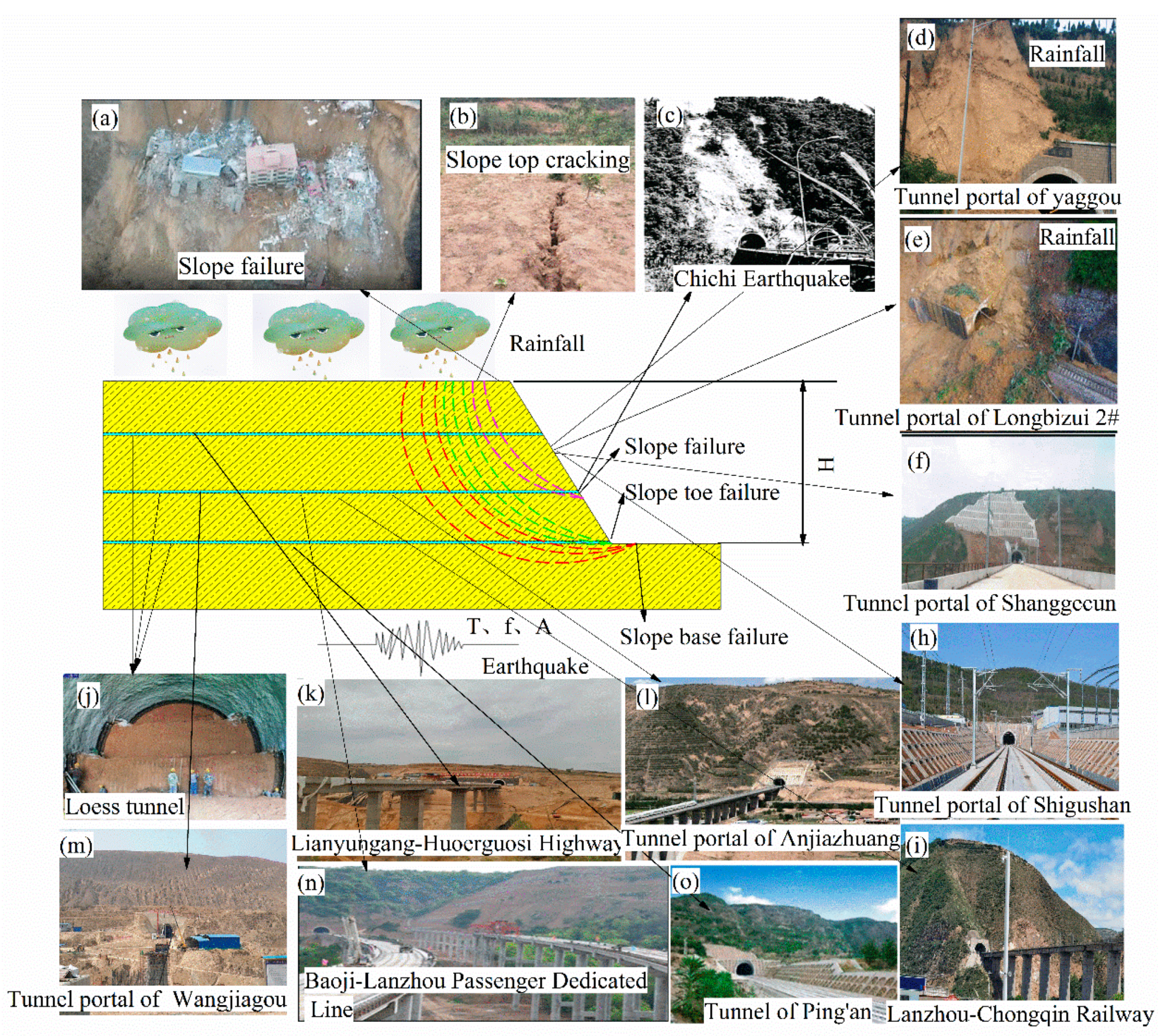
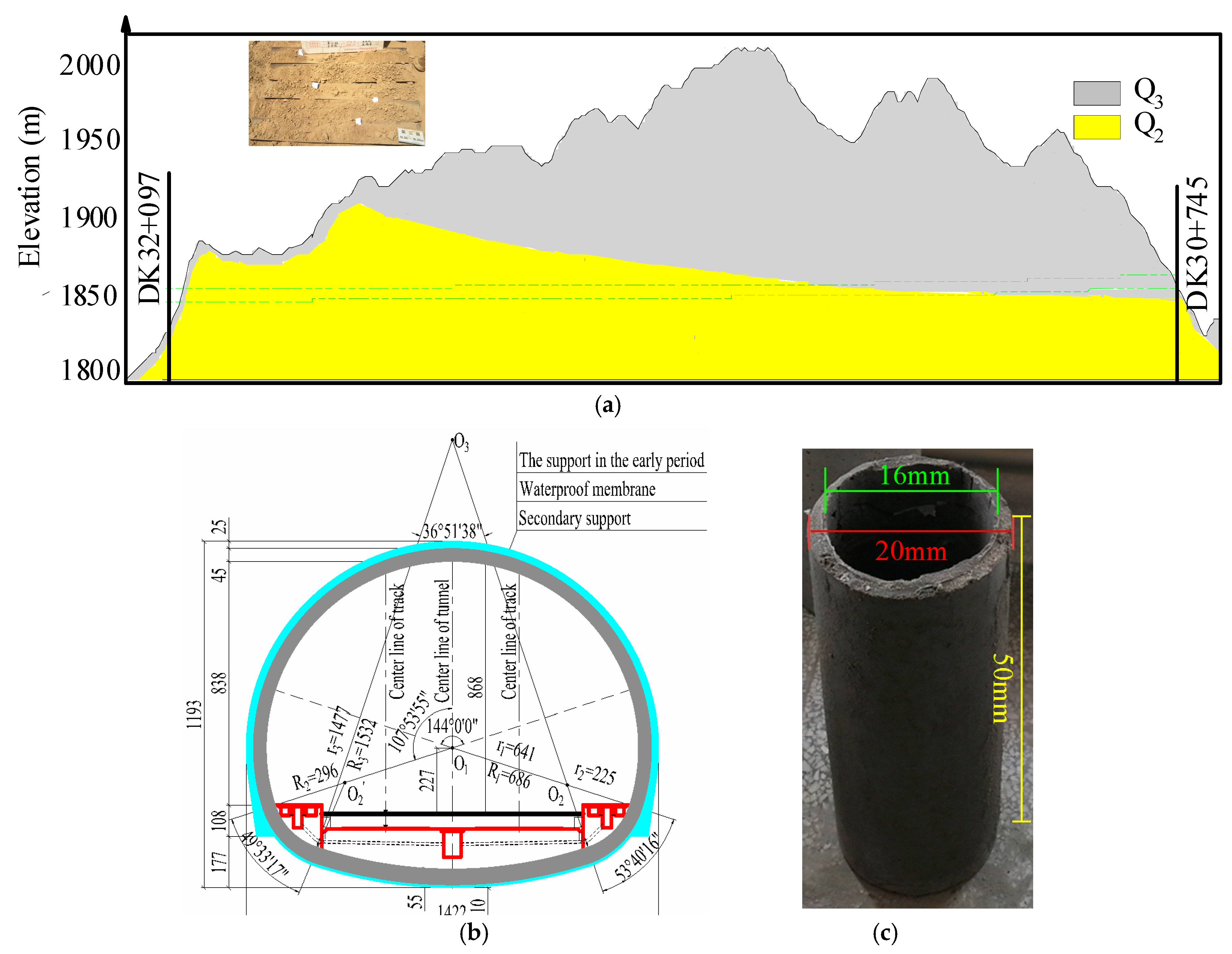
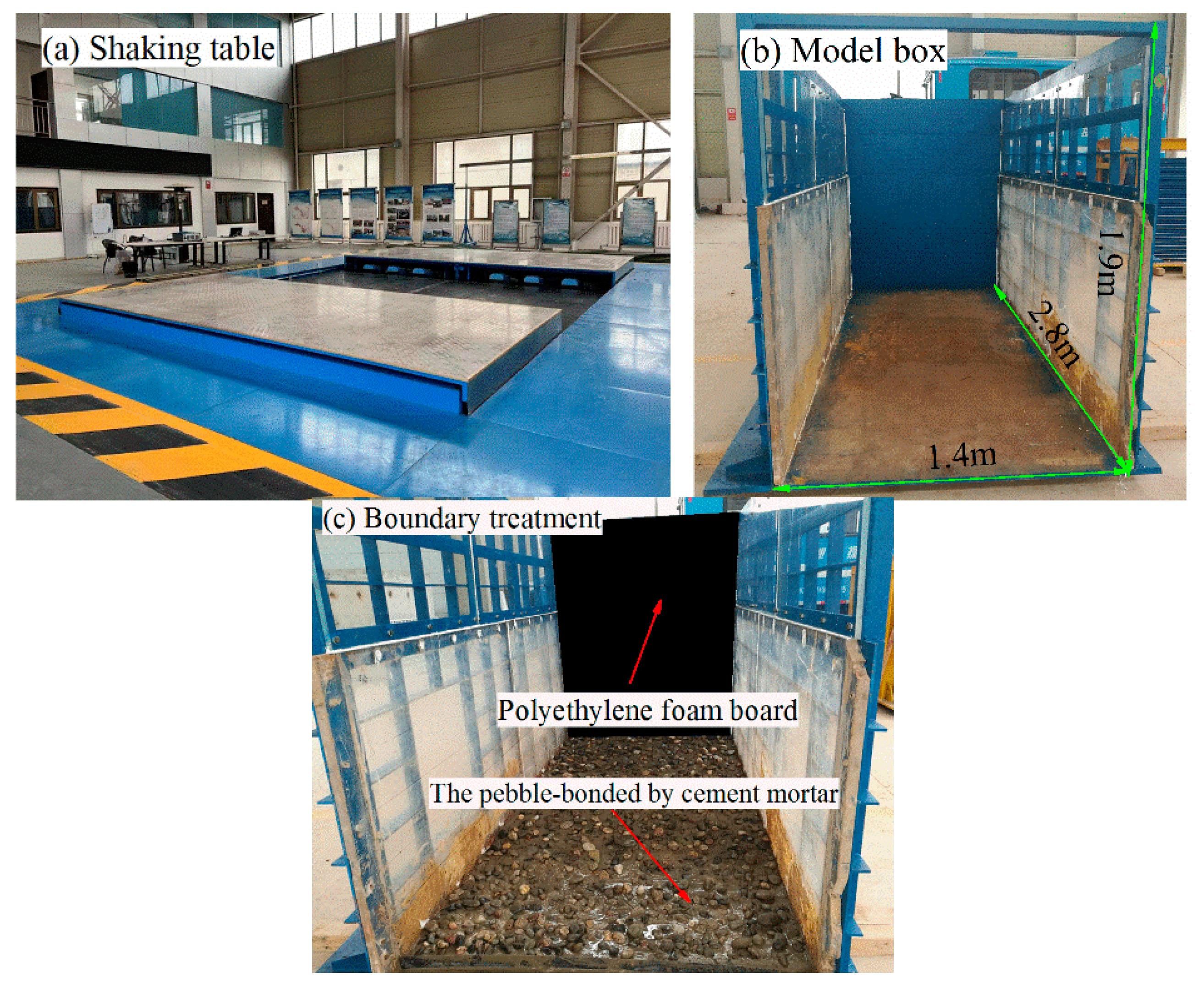
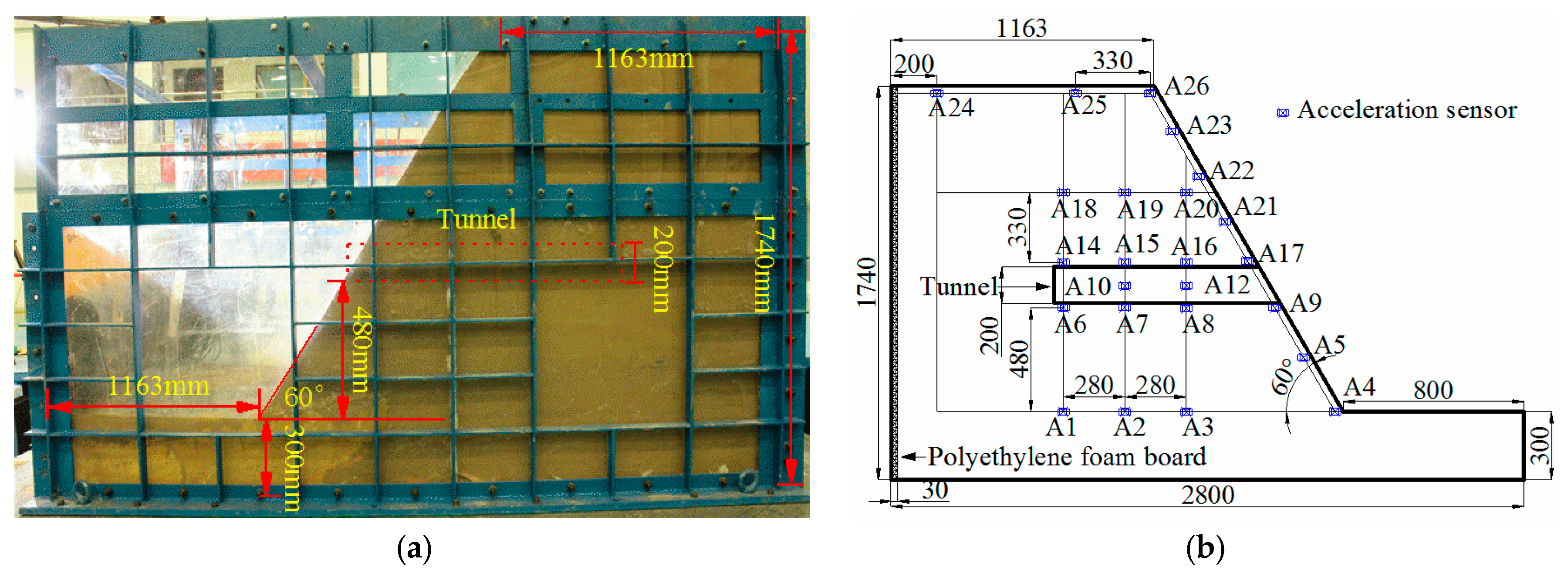
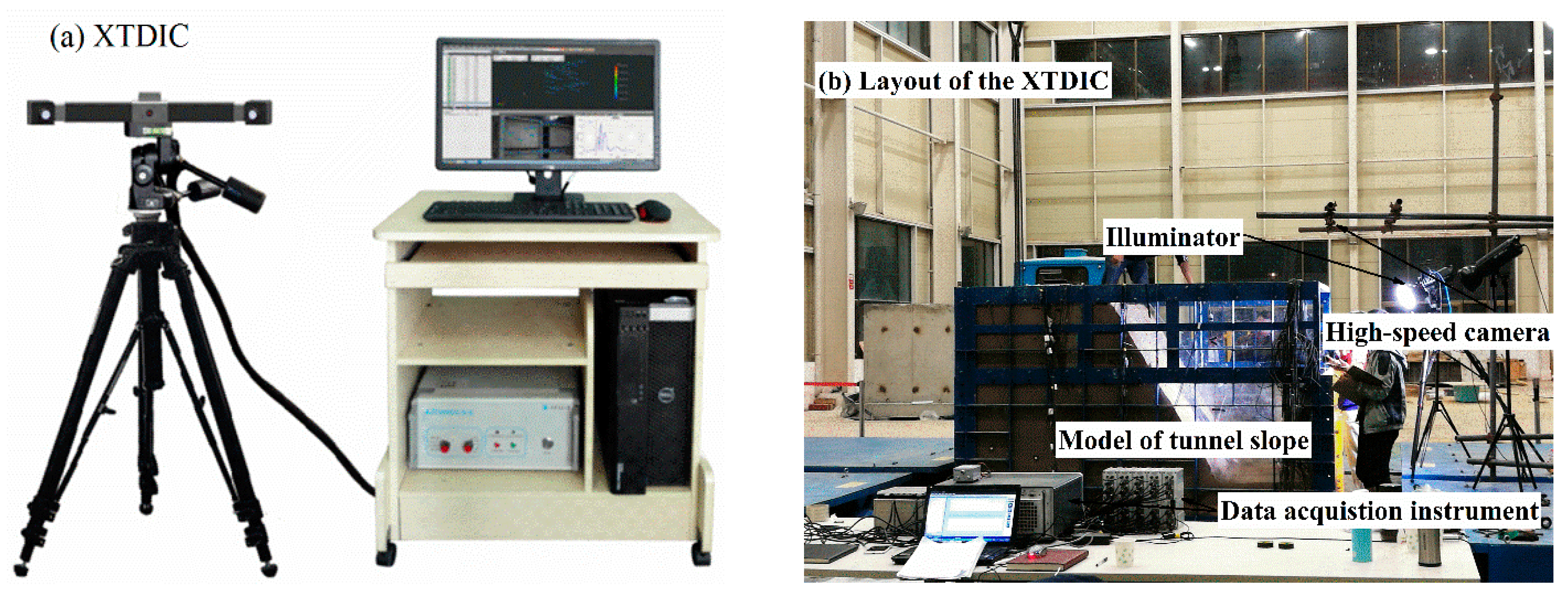
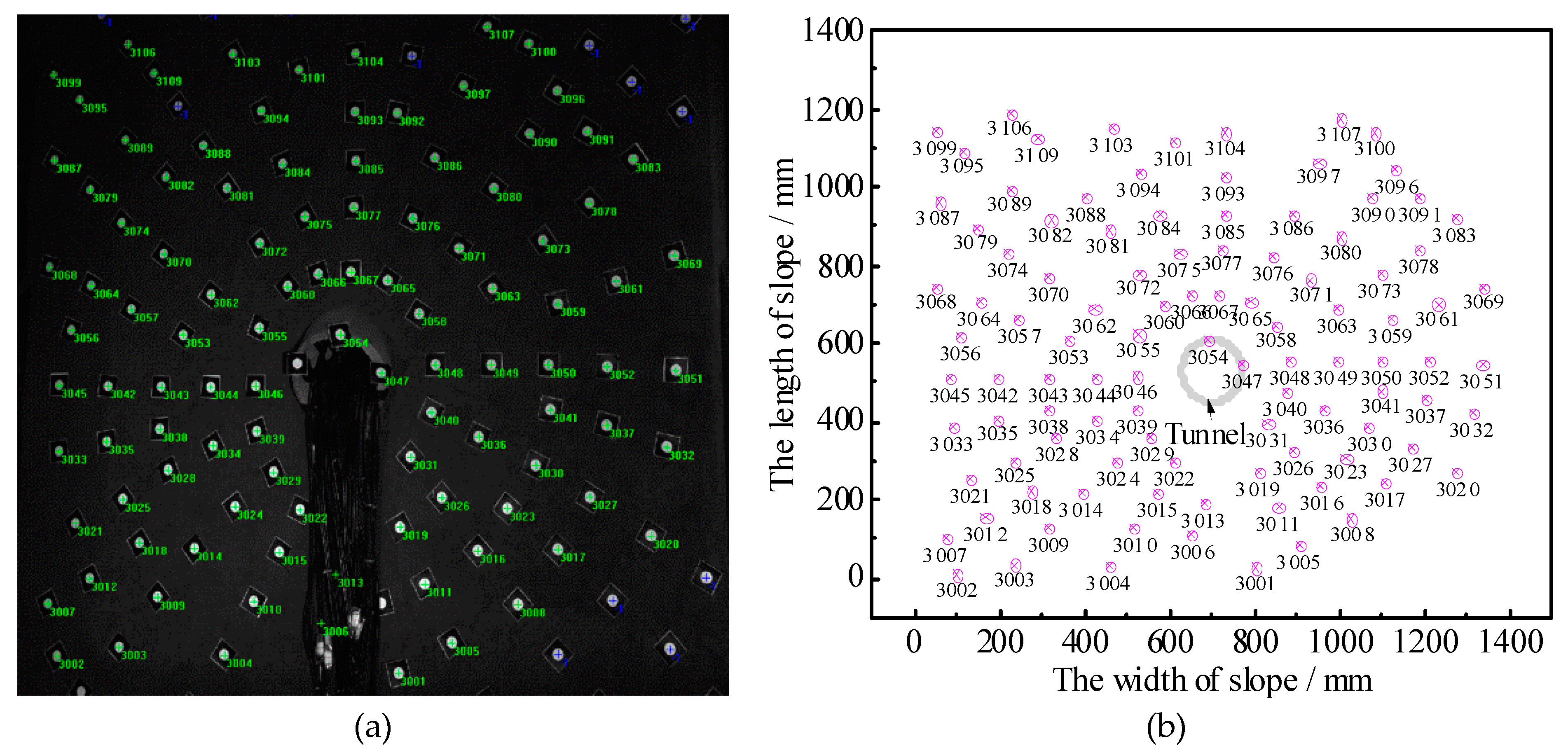
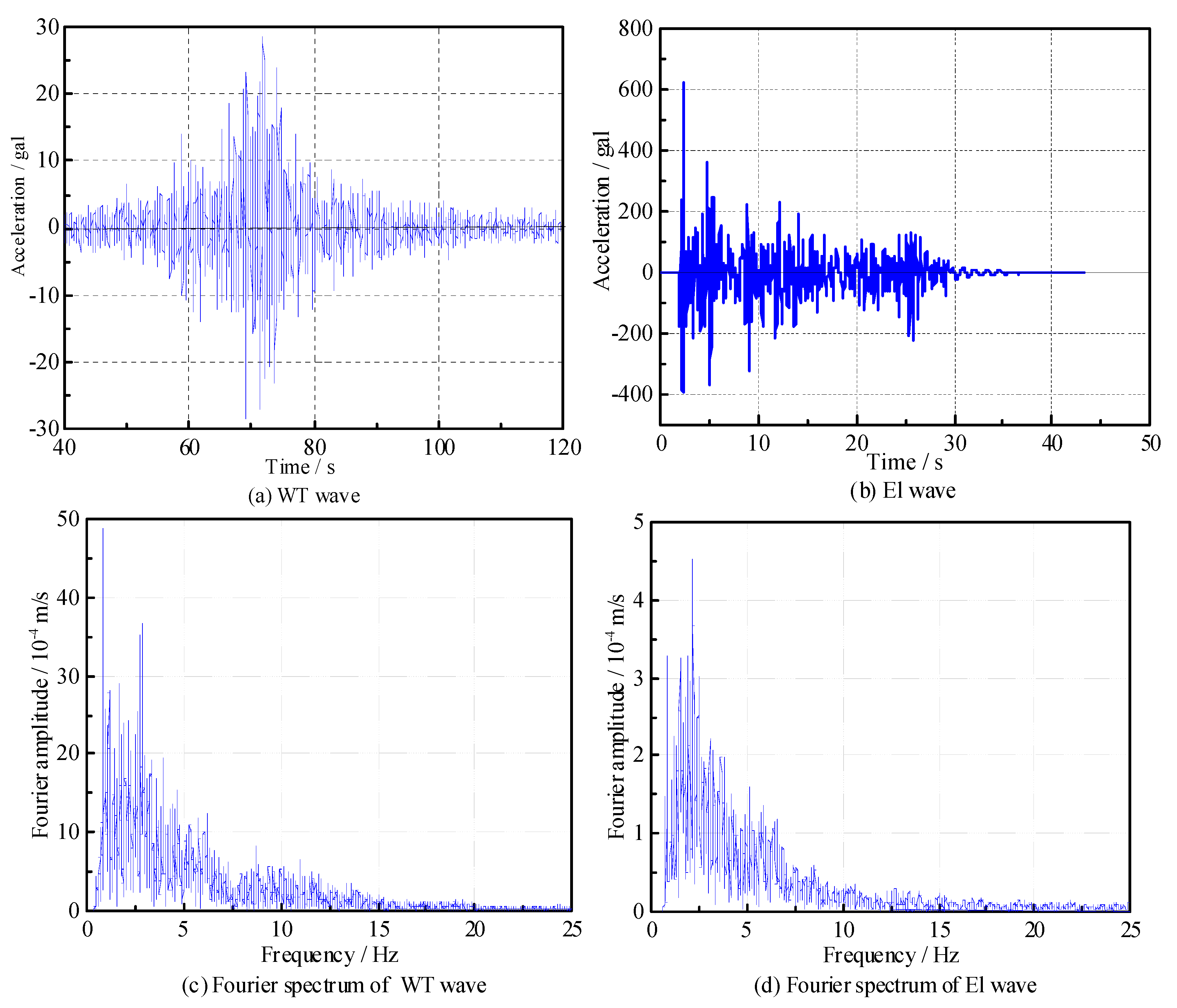
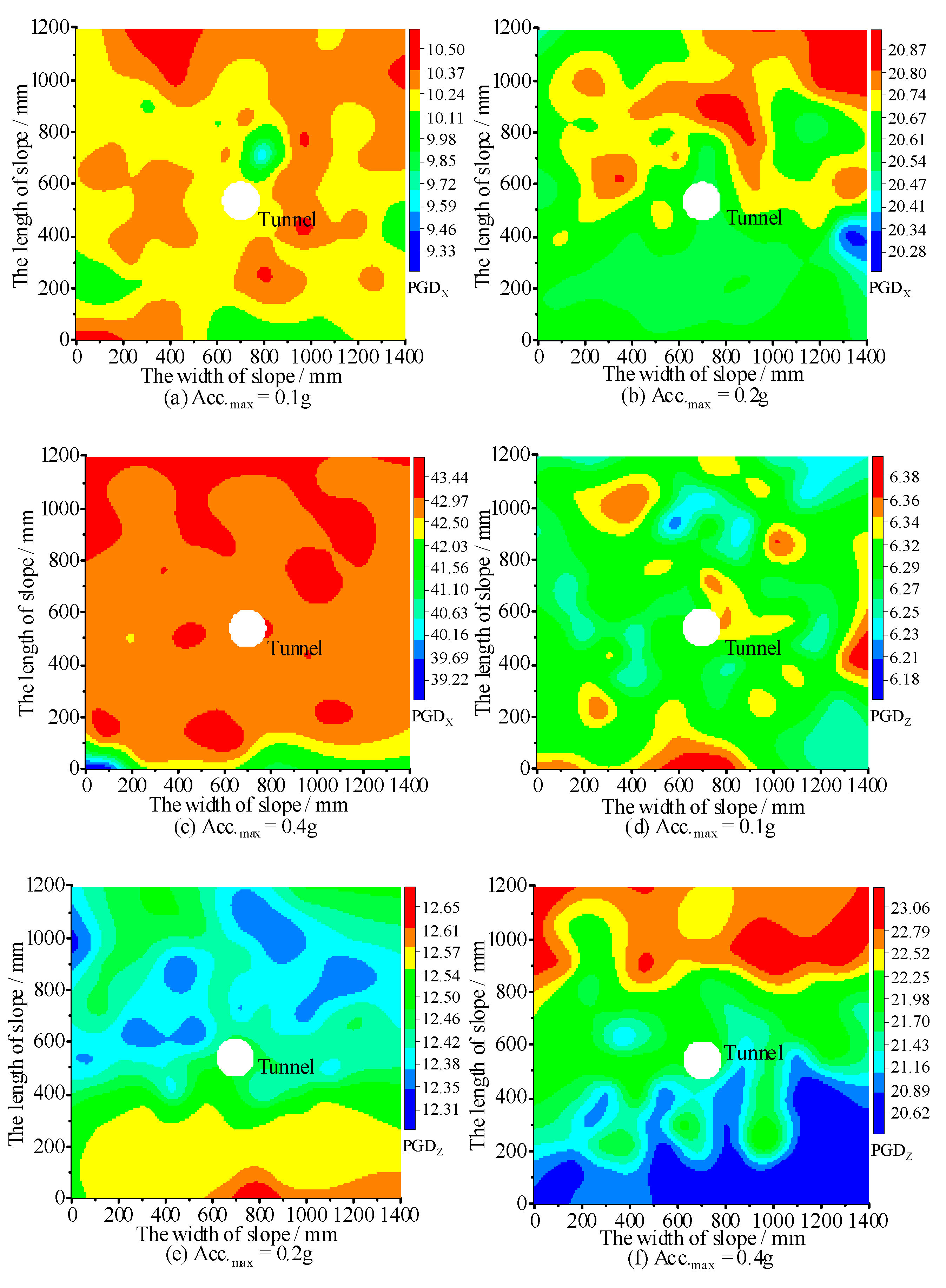
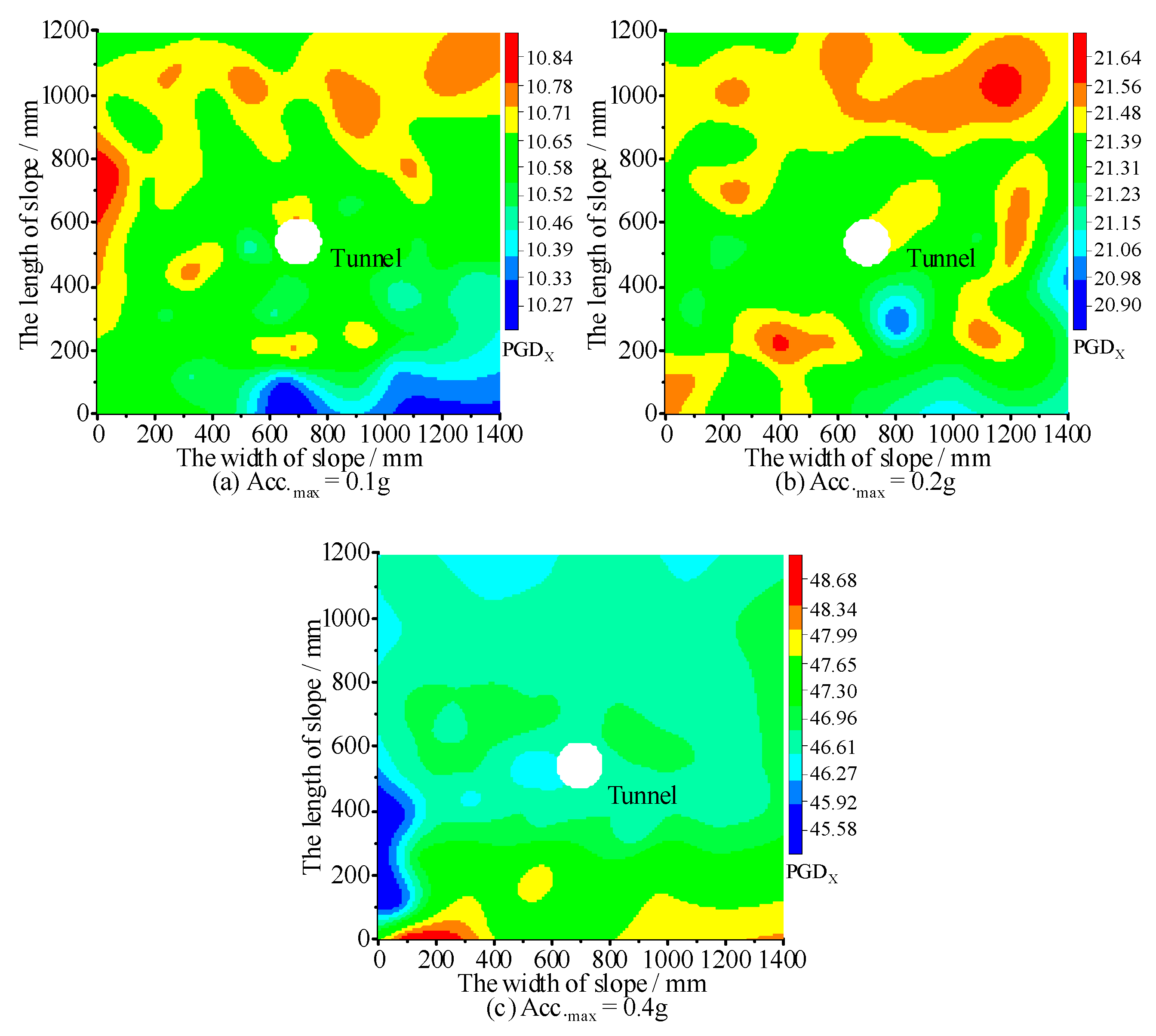
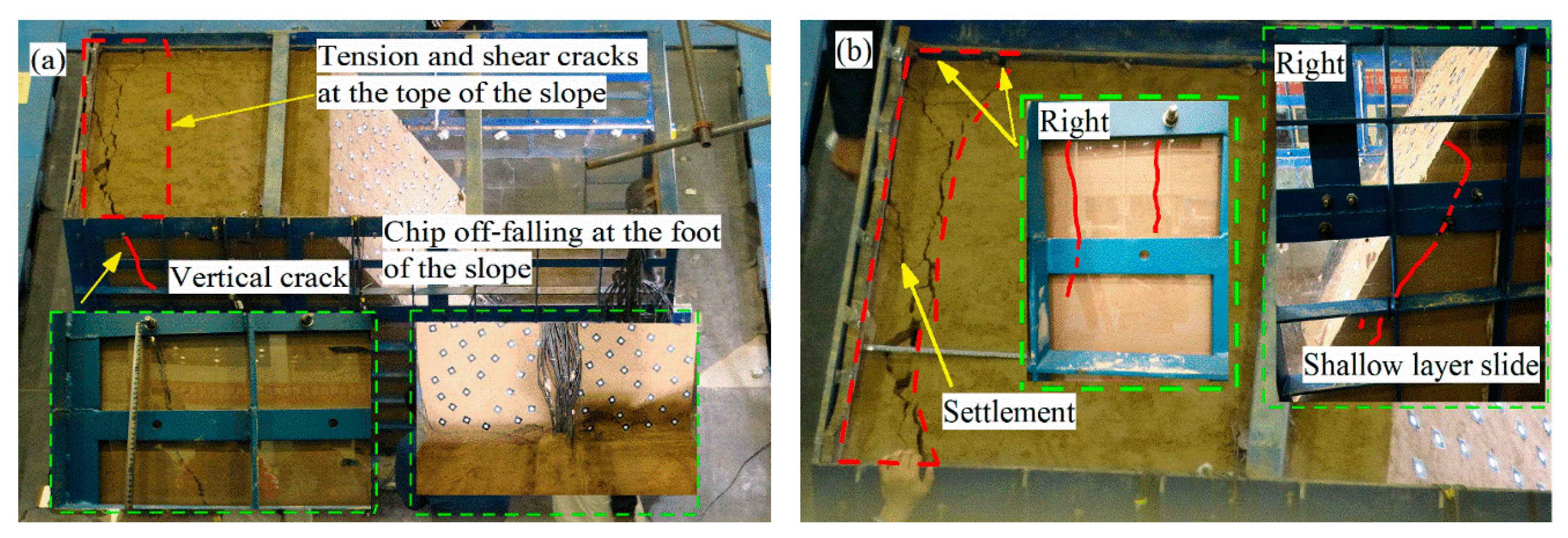
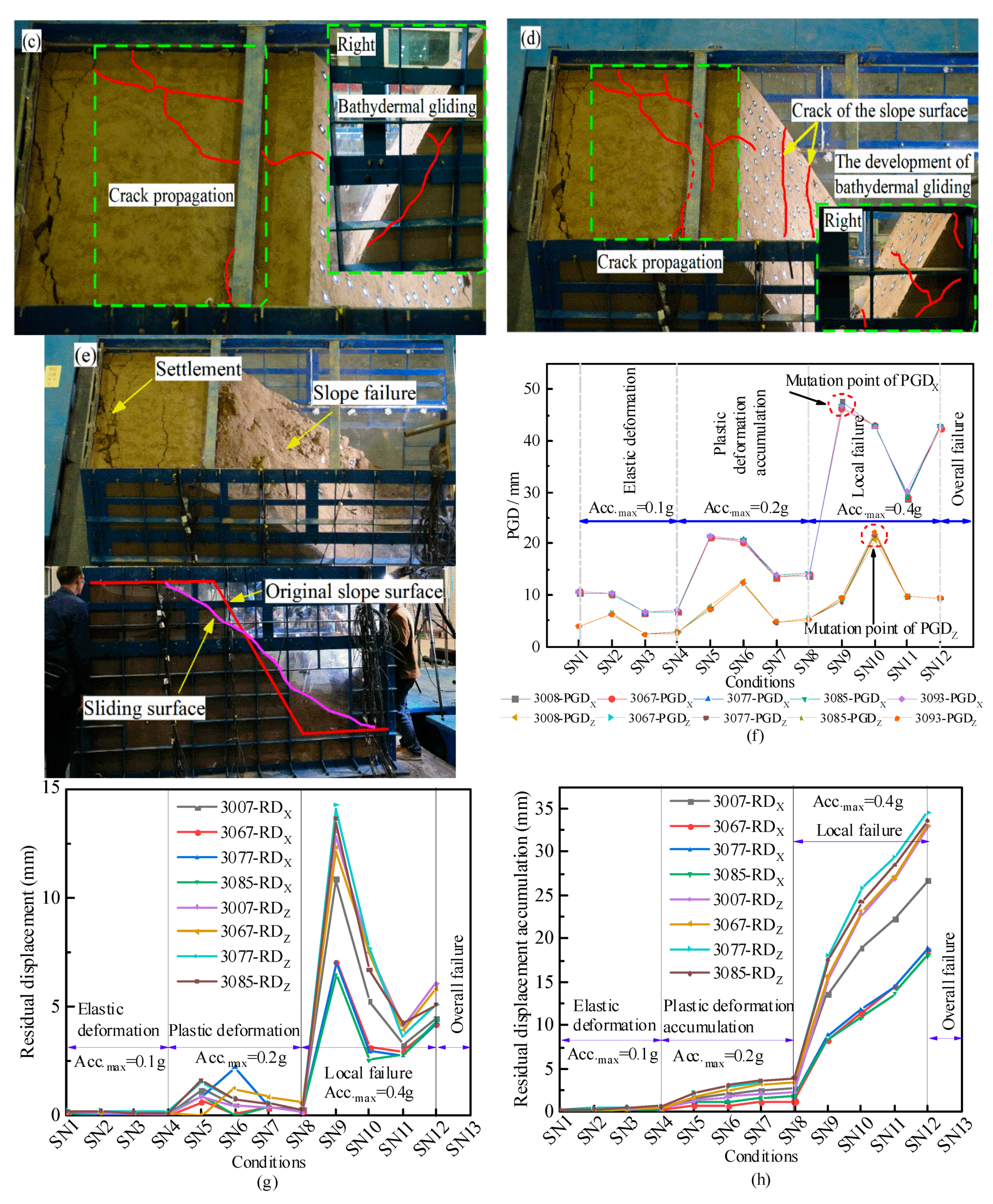
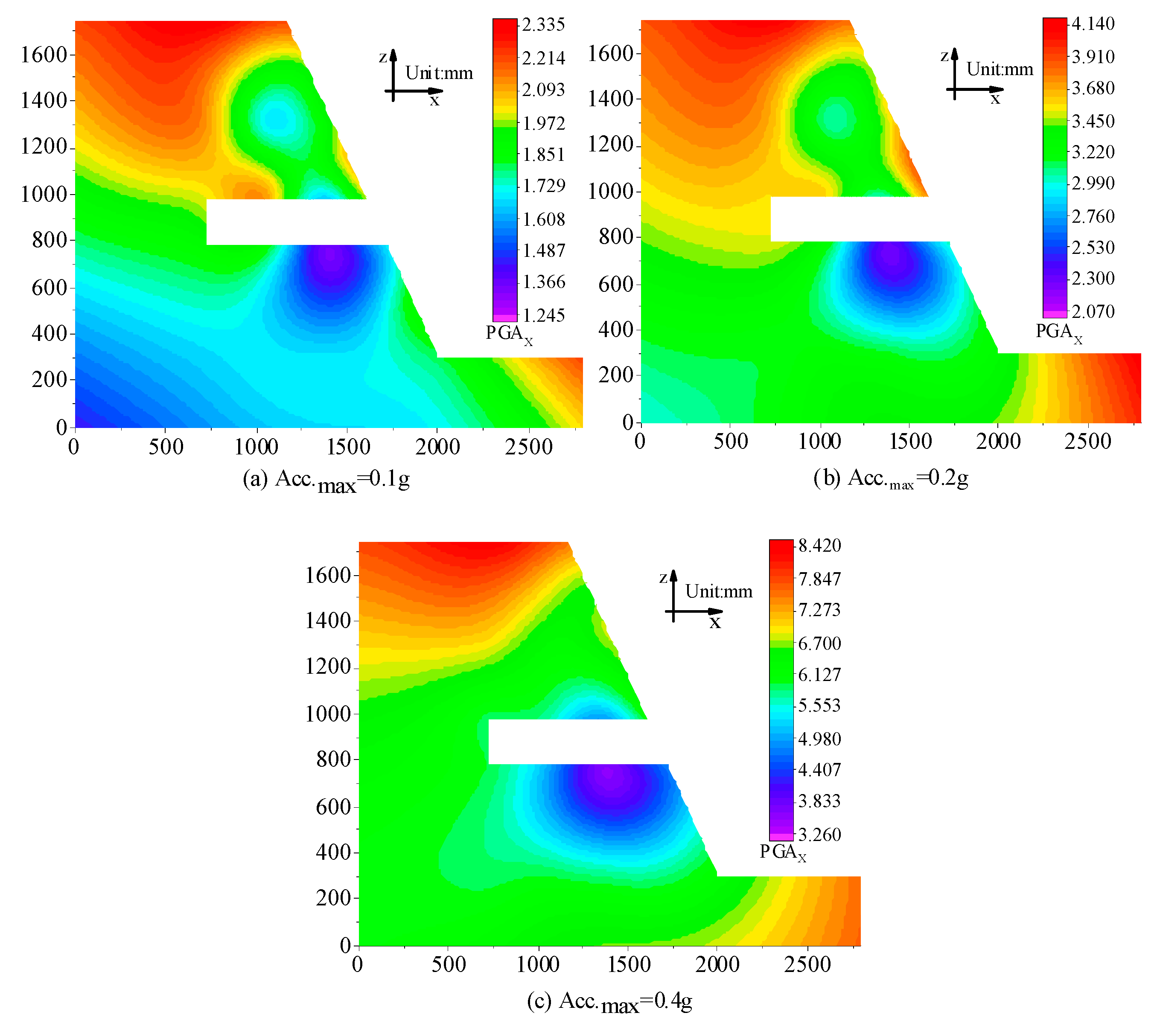
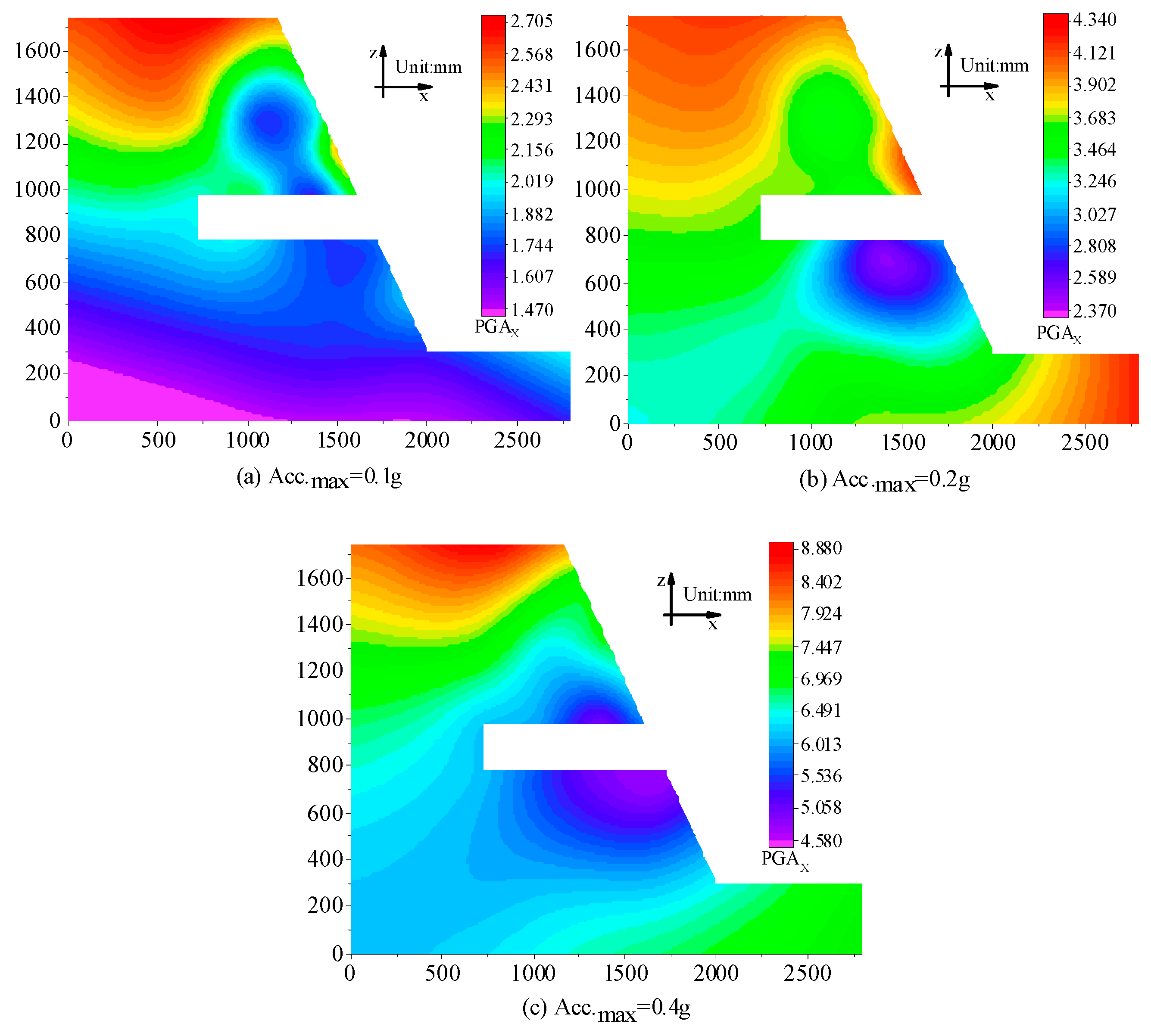
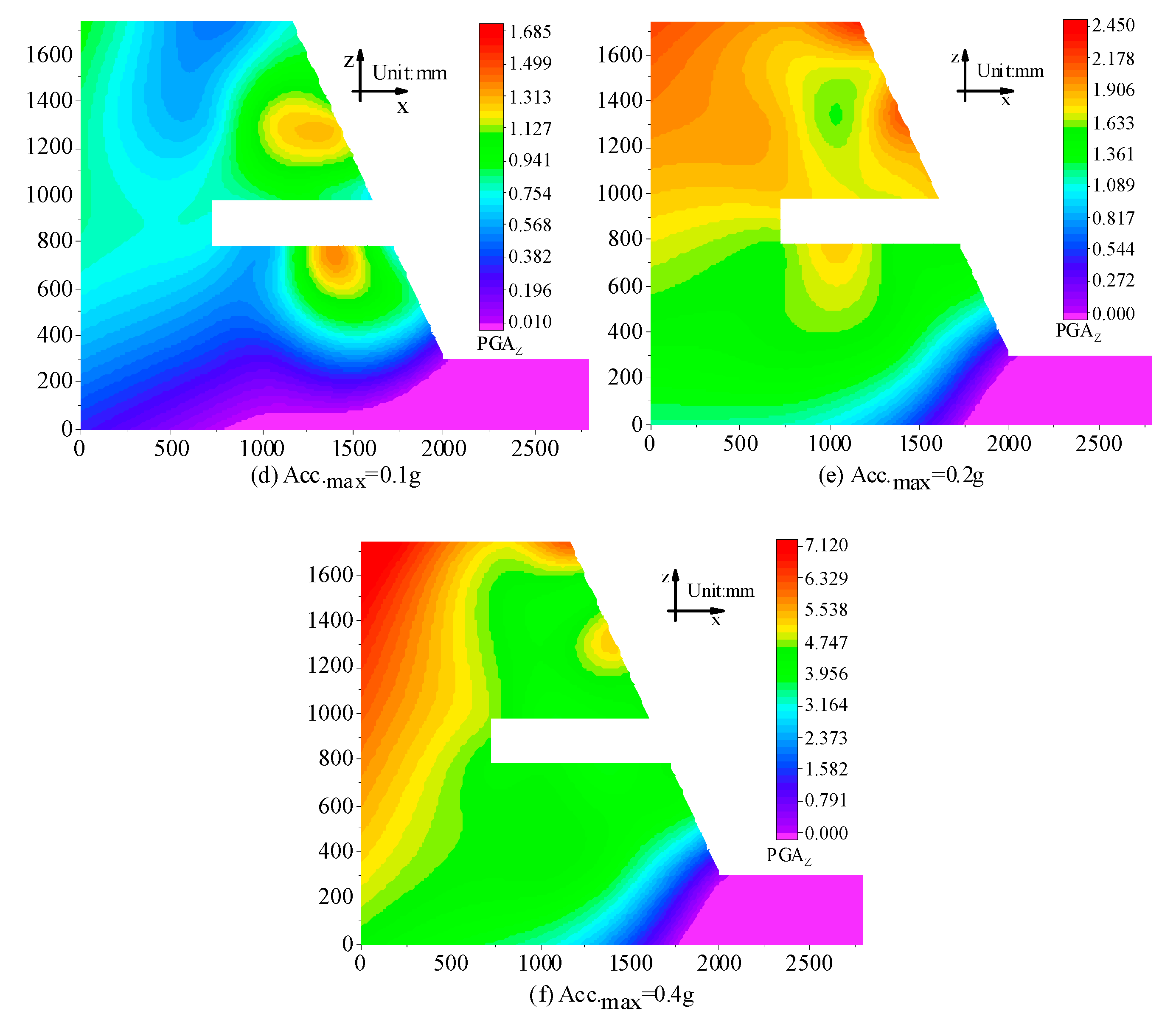
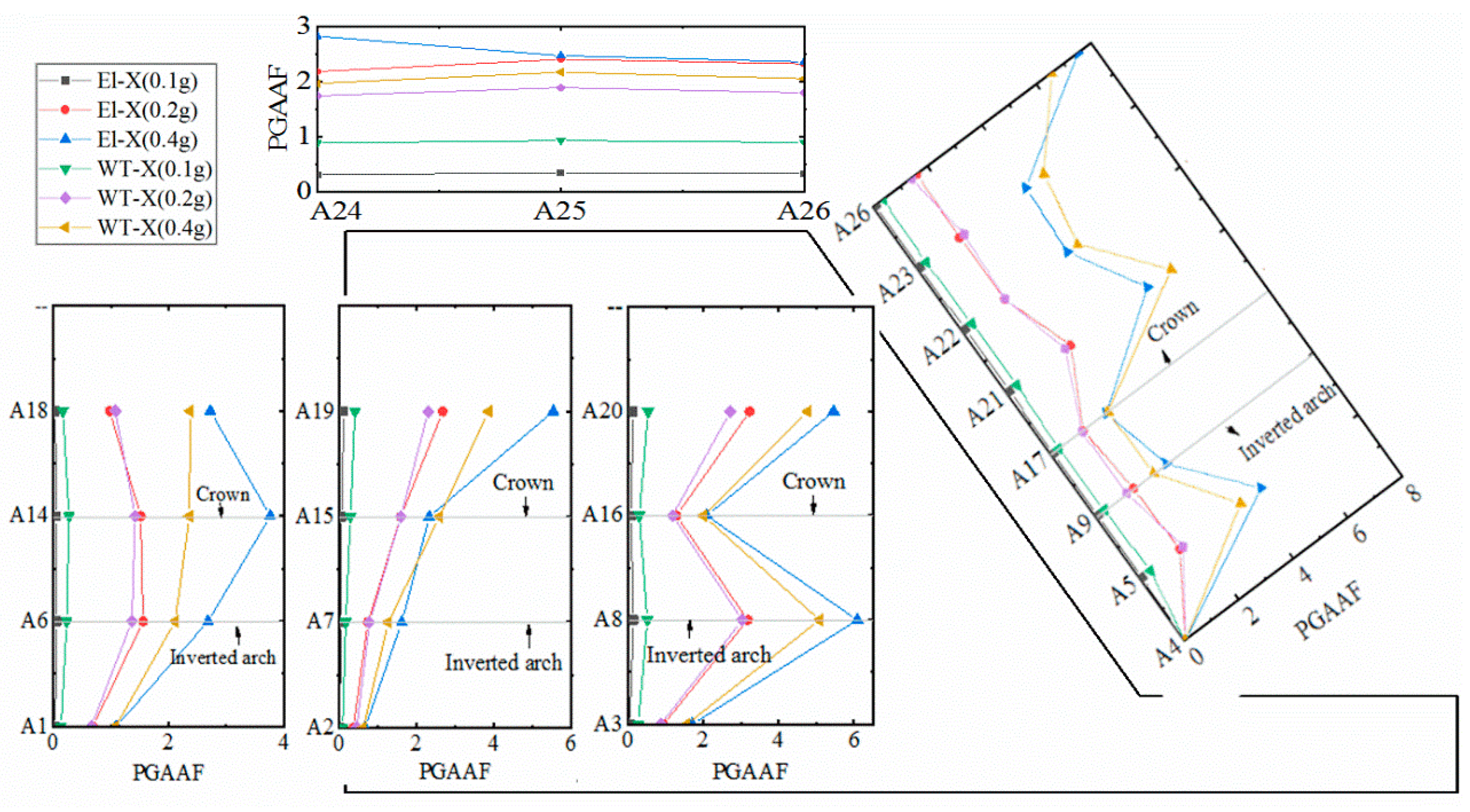
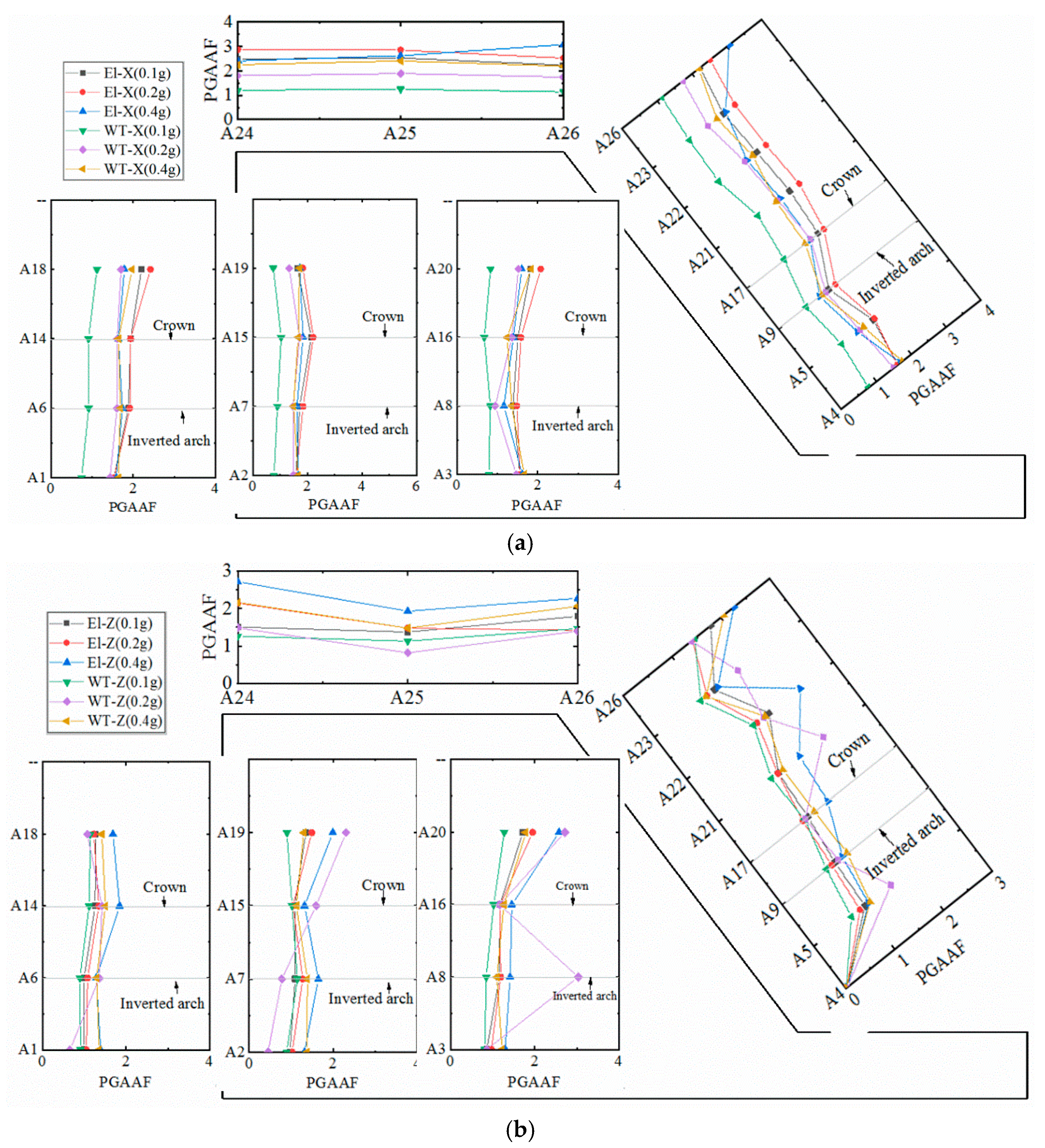
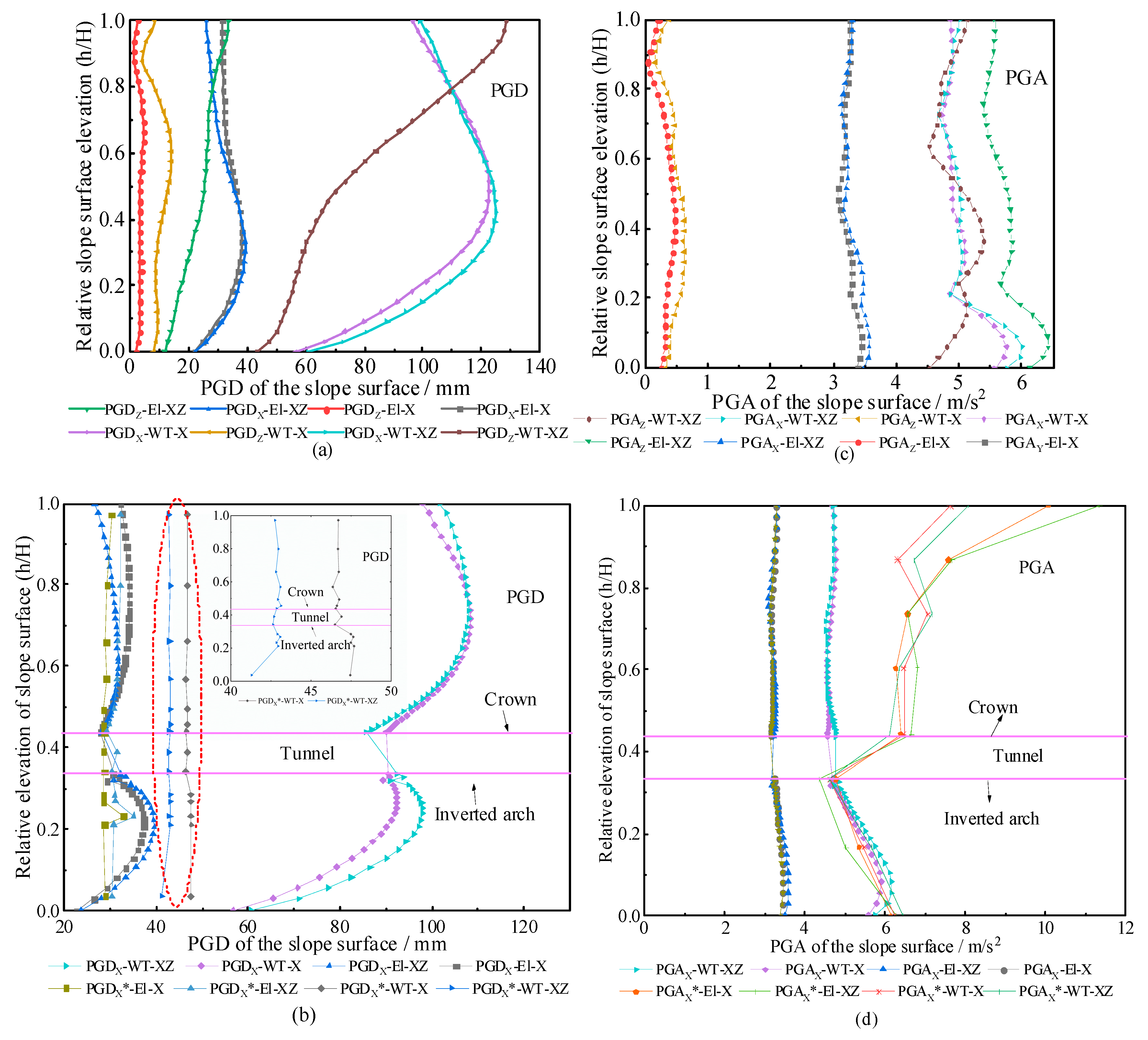
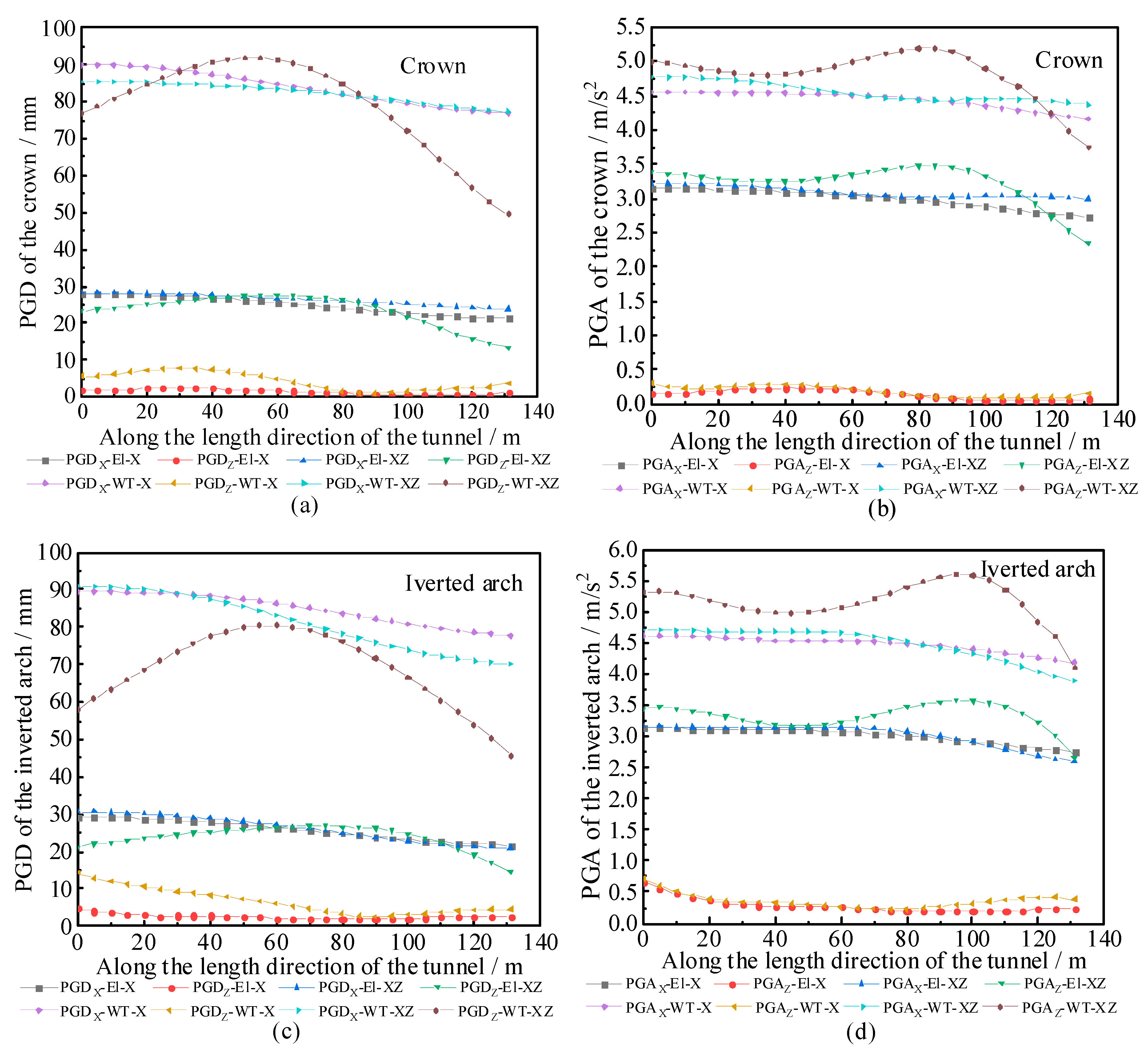
| Physical quantity | Dimension | Similarity | prototype: model |
|---|---|---|---|
| Physical dimension: L | [L]=[L] | CL | 80 |
| Density: ρ | [ρ]=[M][L]-3 | Cρ | 1 |
| Acceleration of vibration: α | [α]=[L][T]-2 | Cα=CL-1Cρ-1CE | 1 |
| Cohesion: c | [c]=[M][L]-1[T]-2 | Cc | 80 |
| Internal friction angle: φ | / | Cφ | 1 |
| Poisson ratio: μ | [μ]=[1] | Cμ | 1 |
| Modulus of elasticity: E | [E]=[M][L]-1[T]-2 | CE | 80 |
| Sample type | ρd (g/cm3) | c (kPa) | φ (°) | ω (%) |
|---|---|---|---|---|
| Prototype soil | 1.5 | 22.4 | 29.8 | 11 |
| Actual model soil | 1.5 | 23.5 | 28.9 | 11 |
| Conditions / SN | Corresponding basic intensity | Amplitude / g | Seismic waveforms | Peak ground acceleration in loading direction / gal |
|---|---|---|---|---|
| SN1 | VII(0.09~0.17g) | 0.1 | WT wave | 116 (X) |
| SN2 | WT wave | 116 (X), 78 (Z) | ||
| SN3 | El wave | 117 (X) | ||
| SN4 | El wave | 117 (X), 54 (Z) | ||
| SN5 | VIII(0.18~0.35g) | 0.2 | WT wave | 233 (X) |
| SN6 | WT wave | 233 (X), 156 (Z) | ||
| SN7 | El wave | 235 (X) | ||
| SN8 | El wave | 235 (X), 107 (Z) | ||
| SN9 | IX(0.36~0.40g) | 0.4 | WT wave | 465 (X) |
| SN10 | WT wave | 465 (X), 312 (Z) | ||
| SN11 | El wave | 470 (X) | ||
| SN12 | El wave | 470 (X), 215 (Z) | ||
| SN13 | Over IX (0.41~0.70g) | Over 0.4 | WT wave | 698 (X) |
| ConditionsSN | PGDX-max(mm) | PGDX-min (mm) | PGDZ-max(mm) | PGDZ-min (mm) | The law of slope surface | |
|---|---|---|---|---|---|---|
| 0.1g | SN1 | 10.54 | 10.27 | 4.04 | 3.66 | PGD of the slope surface difference was small. |
| SN2 | 10.50 | 9.33 | 6.38 | 6.18 | ||
| SN3 | 6.94 | 6.40 | 2.43 | 2.31 | ||
| SN4 | 7.25 | 6.65 | 2.80 | 2.67 | ||
| 0.2g | SN5 | 21.64 | 20.90 | 7.81 | 7.18 | PGD of the slope surface difference was small. |
| SN6 | 20.87 | 20.28 | 12.65 | 12.31 | ||
| SN7 | 14.03 | 13.16 | 4.87 | 4.71 | ||
| SN8 | 14.36 | 13.79 | 5.42 | 5.25 | ||
| 0.4g | SN9 | 48.68 | 45.58 | 11.14 | 8.45 | Chip off-falling at the foot of the slope. |
| SN10 | 43.44 | 39.22 | 23.06 | 20.62 | Approximate horizontal cracks appeared in the middle and upper slope above the tunnel, the foot of the slope was loose, and soil mass fell. | |
| SN11 | 32.84 | 26.62 | 9.81 | 9.58 | Cracking and peeling appear on the slope surface. | |
| SN12 | 35.06 | 28.40 | 12.06 | 9.11 | A large area of chip off-falling appeared on the slope, PGD of the slope surface also showed an elevation amplification effect. | |
| Over 0.4 g | SN13 | / | / | / | / | The slope collapsed. |
| Waveform | Direction | Acc.max | Peak value of the PGA | |||
|---|---|---|---|---|---|---|
| PGAX-max | PGAX-min | PGAZ-max | PGAZ-min | |||
| El wave | Put into X | 0.1g | 2.622 | 1.267 | 0.9785 | 0.009 |
| 0.2g | 4.724 | 2.074 | 1.669 | 0.008 | ||
| 0.4g | 10.073 | 3.877 | 4.168 | 0.010 | ||
| Put into X-Z | 0.1g | 2.409 | 1.326 | 1.378 | 0.009 | |
| 0.2g | 4.804 | 2.493 | 2.809 | 0.011 | ||
| 0.4g | 11.342 | 4.308 | 6.036 | 0.007 | ||
| WT wave | Put into X | 0.1g | 2.332 | 1.246 | 0.958 | 0.007 |
| 0.2g | 4.134 | 2.078 | 1.682 | 0.011 | ||
| 0.4g | 8.404 | 3.272 | 3.469 | 0.009 | ||
| Put into X-Z | 0.1g | 2.703 | 1.473 | 1.685 | 0.011 | |
| 0.2g | 4.335 | 2.380 | 2.448 | 0.009 | ||
| 0.4g | 8.867 | 4.597 | 7.102 | 0.009 | ||
| γ / kN/m3 | μ | c / kPa | φ / ° | E / GPa | |
|---|---|---|---|---|---|
| Surrounding rock | 15 | 0.2 | 22.4 | 29.8 | 0.11 |
| Primary lining | 22.5 | 0.25 | - | - | 32 |
| Secondary lining | 23 | 0.2 | - | - | 30 |
Disclaimer/Publisher’s Note: The statements, opinions and data contained in all publications are solely those of the individual author(s) and contributor(s) and not of MDPI and/or the editor(s). MDPI and/or the editor(s) disclaim responsibility for any injury to people or property resulting from any ideas, methods, instructions or products referred to in the content. |
© 2023 by the authors. Licensee MDPI, Basel, Switzerland. This article is an open access article distributed under the terms and conditions of the Creative Commons Attribution (CC BY) license (http://creativecommons.org/licenses/by/4.0/).




